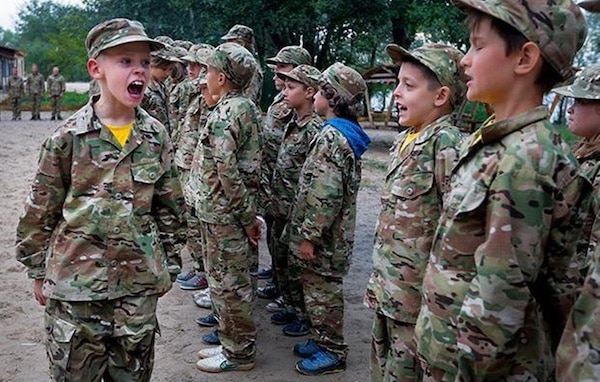Train up a child in the way he should go, and when he is old he will not depart from it.
— Proverbs 22:6, New King James Version
Ukrainian toddler taught to “cut Russians.”
The year is 2015.
The little Ukrainian girl is wearing a Hello Kitty t-shirt that says “love cat.”
She looks to be about four or five years old, maybe younger.
She is holding a knife in her tiny hands.
From off camera, her father says, “Marinochka, will you cut Russians?”
He uses a slur for “Russians.”
“Yes!” She shouts.
“What will you do to them?” He asks.
She shrieks: “I WILL CUT RUSSIANS!”
She repeats this phrase several times and makes little thrusting motions with the knife.
Then she gives a Nazi salute. “Sieg Heil!” She says, “Sieg Heil!”
Her father laughs.
The video of the little girl was posted seven years ago. Well before Russia crossed Ukraine’s borders in February of this year. On YouTube you can find hundreds of videos of Ukrainian children saying they will kill “Moskals,” singing songs about how they are ready to fight for Ukraine, waving knives, shouting slogans and giving Nazi salutes. Such videos are all over social media and they have been appearing for many years.
This may come as a shock to you. But it’s only shocking if you do not understand the history of Ukraine and what has been happening there since 1991, when the Soviet Union broke apart and all of its republics declared independence.
Independence has been important to Ukrainians since at least the 1920’s, when the Organization of Ukrainian Nationalists, the OUN, was founded. I have previously written about the atrocities of the OUN and its leaders including Stepan Bandera, a Nazi who served alongside the Wehrmacht during Operation Barbarossa.
It is indisputable fact that the OUN, led by Bandera, murdered more than a hundred thousand people. In fact, the bodies of the victims are still being exhumed today.
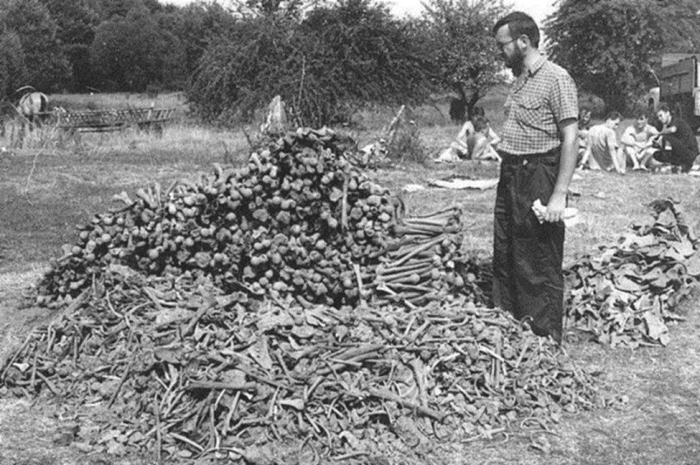
The list of the OUN’s atrocities is long and well-documented despite the “amnesia” which seems to have swept over much of Europe. Here are the most famous ones:
1. The Lvov pogrom of July, 1941 in which several thousand civilians, mostly Jews, were brutally tortured and murdered.
2. The massacre of Babi Yar near Kiev between 1941 and 1943, in which Ukrainian nationalists were complicit in the murder of tens of thousands of people including Jews and Ukrainians loyal to the Soviet Union.
3. The liquidation of the Jewish ghetto in Rivne in July 1942, where over five thousand people were killed.
4. The razing of the Belarusian village of Khatyn in March, 1943.
5. The massacre at Wołyń, a region in Nazi-occupied Poland that is now part of present-day Ukraine. There, between 1943 and 1945, more than 100,000 Poles were slaughtered, along with several thousand Ukrainians who were thought to be “Soviet sympathizers.”
And that is only a partial list.
Feel free to check all of the links I included in the above list. Even The Smithsonian does not shy away from giving credit to the Nazis’ Ukrainian collaborators.
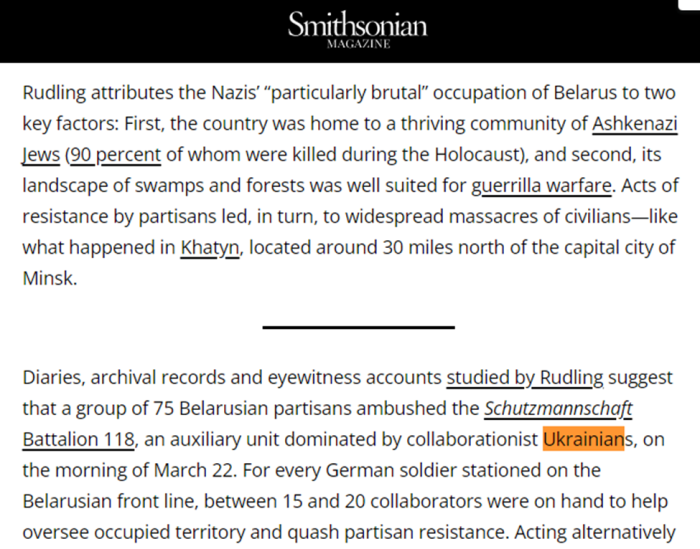
The OUN behaved like bandits, raiding farms and villages and targeting civilians. They slaughtered Jews, Roma, Russians, communists and anyone they suspected might be loyal to the Soviet Union. The Banderites wanted a racially pure Ukrainian ethno-state and they believed that anyone who was not Ukrainian needed to be purged.
That is the story which history tells.
But it is not the story taught to Ukrainian children.
The Rebel ABC’s
In 2013, schools received the first edition of “The Rebel ABC’s,” a textbook which teaches elementary-school children the Ukrainian alphabet with a colorful cartoon story about the OUN.
Unlike the real OUN who roamed the back-country raping, murdering, looting and burning, the OUN in this textbook is portrayed as a merry band of friends who romp around the countryside doing good deeds. The author of the book, Oleg Vitvitsky, is proud that the textbook will teach children to be “real Banderites.” He designed it like a comic book and gave the characters cute names like Alyarmik, Adolfik, Liliputin and Medvedchukovich.
There are more pictures in the book than text, but let’s take a look at what the text says.
For example, here is the letter “M.”
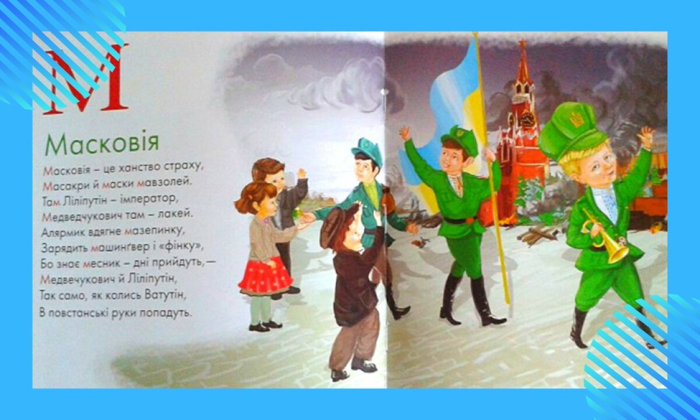
Here you can see little Alyarmik, the hero of the story, whose name means “alarm,” carrying his trumpet and leading his merry band of Banderites. In the background, the Russian Kremlin is ablaze.
“M” is for “Maskovia,” which means “Muscovy,” an archaic name for Moscow. The word is written with an “a” instead of an “o,” which mocks the Russian pronunciation of the word.
There is a short poem:
“Muscovy is the Khanate of Fear,
Massacres and mausoleum masks,
There, Liliputin is the emperor,
Medvedchukovich is a lackey there,
Alyarmik will put on his mazepinka
He’ll load his machine gun and his finka
Because he knows the day will come
When Medvedchukovich and Liliputin
Just like Vatutin of old
Will fall into rebel hands.”
Liliputin is, of course, a reference to Vladimir Putin, and Medvedchukovich is a reference to Dmitri Medvedev and former Ukrainian president Viktor Yanukovich, who was ousted during the 2014 Maidan coup.
Mazepinka is the type of cap worn by the OUN and finka is a dagger.
Vatutin was a Red Army general who liberated Kiev from the Germans and was later killed by Bandera.
The word used for “machine gun” (mashingver) is derived from a German word, “Sturmgever,”which was a type of assault rifle produced by the Third Reich in 1944.

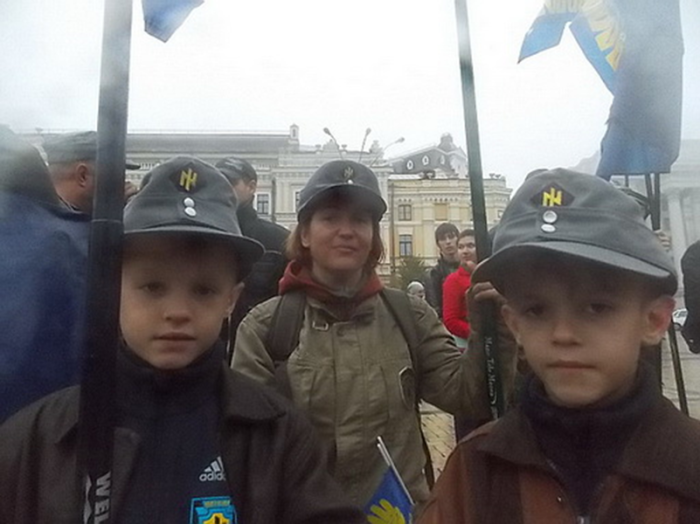
A Comic Book History of Ukraine
You might feel that it’s understandable for Ukrainians to bear such hatred for Russians, in view of the current war. But the Banderites have been teaching children to hate the “Moskals” (a slur meaning “Russians”) for decades. They have long cared about the “education” of future “warriors of Ukraine.”
In 1996, a comic book was produced portraying Stepan Bandera as a hero, and then in 2007, it was reprinted with the title “Ukraine in its Struggle.”
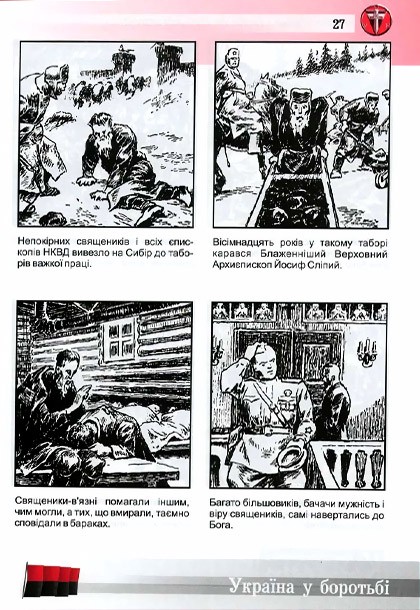
The comic tells of brave insurgents who selflessly fight the “Moskal murderers” The artist, Leonid Perfetsky, depicts the OUN soldiers, compatriots of Hitler’s Wehrmacht, as daring heroes fighting against the Soviet allied forces in World War Two. The Soviets, of course, are depicted as ugly and bloodthirsty.
Perfetsky himself was a member of the SS division Galicia, and he originally created the drawings for leaflets and newspapers produced by the Ukrainian Insurgent Army. In 1953, the drawings were collected and printed by a daily newspaper run by Ukrainian diaspora in Philadelphia, United States. In the 1970’s, the drawings appeared in the magazine of the Union of Ukrainian Youth, “Krylati.” In 2013, the comics were published in a book and 2,000 copies were distributed among libraries and public organizations, according to Yaroslav Lipovetsky of the Department of Family and Youth Affairs of Ternopil, a major city in western Ukraine.
According to Lipovetsky, at first they wanted to publish the comic as a coloring book, however this idea was abandoned and the text was carefully edited to bring it closer to the modern Ukrainian language. The first edition was distributed to school and college libraries. Later, 12,000 copies were published in Ukrainian, and then 10,000 more were published in the Russian language and distributed in southeastern Ukraine, which is primarily inhabited by Russian-speakers.
In 2008, the comic “Murders by Order of KGB” was published for children, about how the KGB killed Stepan Bandera.
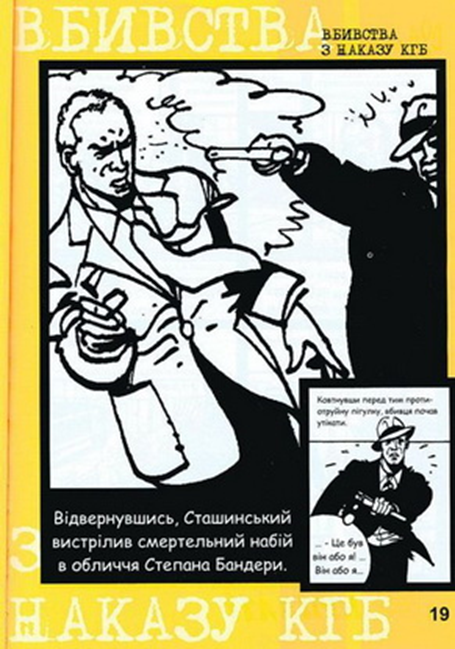
This comic, really more of a graphic novel, was published by the Union of Ukrainian Youth. According to the developers, there is nothing humorous in it and it’s intended for children 13 and older — “those who are in search of a political ideal.”
A girl at a school contest in Lvov famously said, “You need Bandera to come to you, to your world as a relative, as a father, as a brother, as something native and inalienable.” Her call was heeded by the Kapranov brothers, fervent nationalists and members of an organization called “Trident,” which was named after Stepan Bandera. And in 2011, they published a book called “Bandera and I,” which was included in an educational series for children called “Twelve Points,” about prominent Ukrainian figures.
In this book, two schoolboy brothers hear someone on TV calling the Banderites “fascists.” They set about investigating Bandera for themselves, to find out if he is a hero or a mass-murderer. And in their history classroom, they find a portrait of Bandera wrapped in a towel. Then members of Svoboda (“Freedom,” a nationalist political party) proceed to educate the young lads. The conclusion of the book is predictable: The brothers determine that Bandera is a hero.
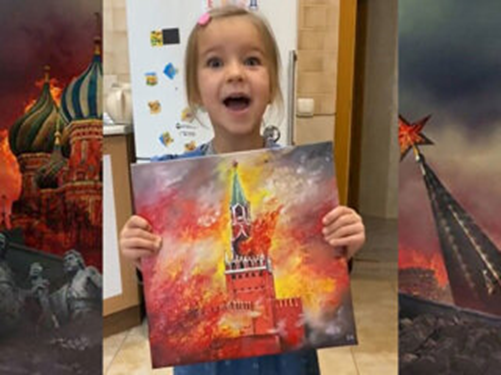
In 2021, the Russian publication Vesti published an article titled “Hate Education: Why Ukrainian Children Are Being Set Against Russia.”
The article is about the above photo of a Ukrainian preschooler holding a painting of the Russian Kremlin, which is burning and belching smoke. Flames are blazing from Spasskaya Tower, the Kremlin’s historic clock. The photo was a big hit on the internet and was reposted hundreds of times with thousands of enthusiastic comments about the “beautiful” new generation growing up in Ukraine.
In a video (which may require a VPN to view) the little girl says “Hi, I’m not Katrusya, but Darusya, and this was not drawn by me, but a girl from Kharkov. I am very pleased that you call me popular, because Putin’s castle is on fire in the picture!” She cheers, “Hooray!”
To the preschooler, the Kremlin is a fairy tale castle, and Putin is an evil character like the wicked Queen in Snow White or Sleeping Beauty.

From comics to camps
But the “education” doesn’t end with fairy tales and comic books. Ukrainian children are also taught how to fight, how to fire an assault rifle, and how to kill.
The following video, produced by a Russian TV show called “Current Time,” was uploaded to YouTube in 2015. It shows children of all ages wearing military fatigues, running obstacle courses and firing automatic weapons at a training camp run by Ukrainian nationalists.
Forty seconds into the video, the correspondent talks to the instructor who downplays her questions about the Nazi symbols the children are wearing and the Nazi salutes they perform.
“The fact is that they took this gesture here ‘from the heart to the sun,’ and they said ‘Sieg Heil,’” which Hitler came up with,” he explains awkwardly.
The Nazi Party slogan was actually the brainchild of Rudolf Hess, who began shouting it after feeling inspired by one of Hitler’s speeches. The phrase was then picked up by the mob of adoring fans listening to their Führer.
After talking to the instructor, the narrator introduces a boy, age nine, who she says already knows how to fire an assault weapon.
“Who will you fight?” She asks the boy.
“Enemies,” the boy replies.
“What enemies?” She asks.
“Any.”
“Do you realize you can go to war from here? Aren’t you afraid?”
“No.”
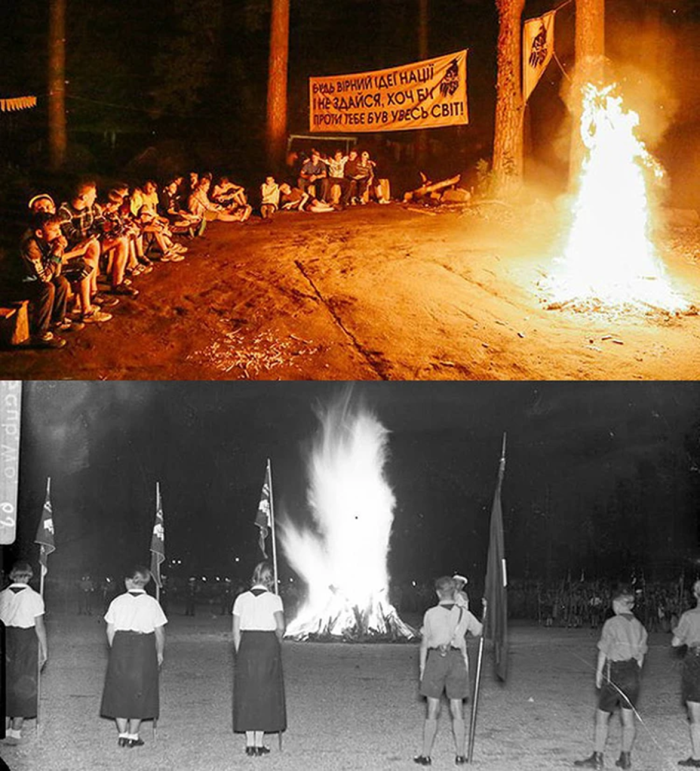
In 2015, the Russian publication Komsomolskaya Pravda wrote several articles about the camps where youths are taught the “right spirit of Ukrainian Aryans.” Nationalists set up a network of camps for children, teenagers and young adults in western Ukraine where they are taught weapons handling, shooting, hand-to-hand combat and even how to fight with knives.
The camps were formed after the Maidan coup in 2014 in seven regions of Ukraine: Kiev, Kharkov, Chernigov, Cherkasy, Zaporozhye, Dnepropetrovsk, and Transcarpathia.
Azov Battalion, the notorious neo-Nazi group, even have a camp called “Azovets,” for children and teenagers, on the outskirts of Kiev. In Odessa, you can find “Camp Chota,” where Pravi Sektor (Right Sector) runs things. Children ages four and up can join the “Carpathian Legion,” and there are several camps run by Svoboda Party. The network of camps welcomes boys and girls of all ages.
At the Azovets camp outside Kiev, anywhere from 400 to 500 children are given Nazi paramilitary training during the summer. These camps have been run every summer, and even during the spring, fall and winter, in every year since Maidan. The camps are free to the children and are financed by western grants and state funding from the Ministry of Youth and Sports of Ukraine.
The focus of the training is to kill “Moskals” and “Separatists.” Kids are taught to kill with assault rifles, carbines, pistols, knives and fists. Then they learn tactics, hand-to-hand combat, assembly and disassembly of submachine guns.
In 2014, the children learned to shoot at targets.
Later on, their training complete, they joined the ranks of Azov Battalion and other nationalist militias and shot at the Russian-speaking people of Donbas.
Where did their childhood go…?
I leave you with some photos which I found while searching Yandex.
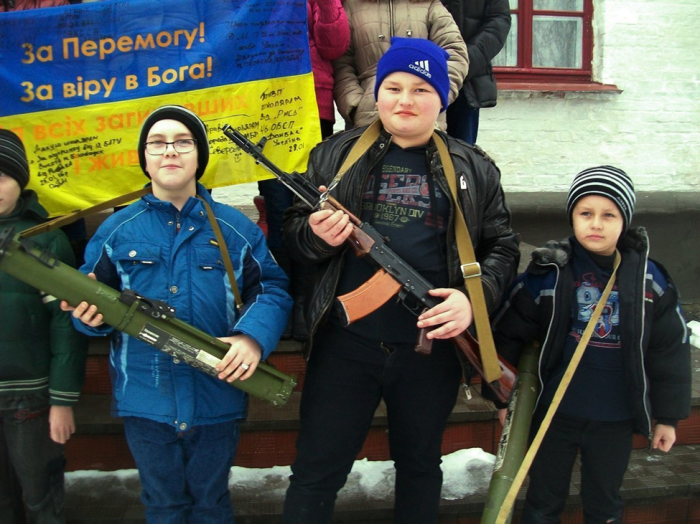
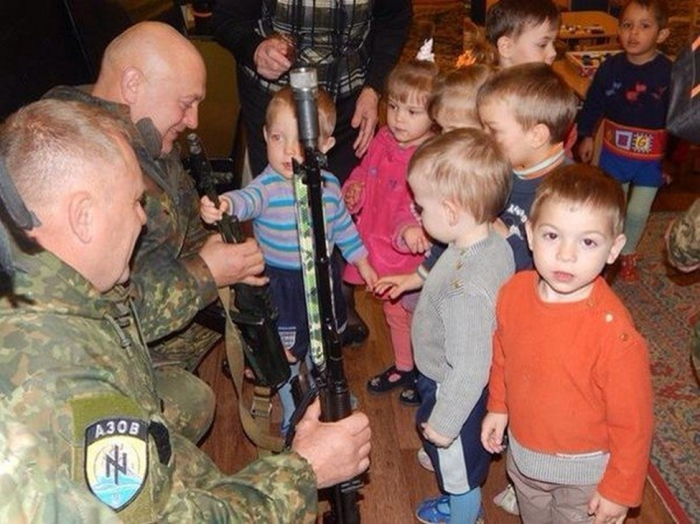
Part II

“Brother will betray brother to death, and a father his child; children will rebel against their parents and have them put to death.”
— Matthew 10:21 New International Version
Despite attempts by Ukrainian nationalists to portray themselves as racially pure Viking Aryans untainted by inferior Russian blood, in truth Russians and Ukrainians share the same genetic roots which stretch back to ancient Rus` and the times before that.
Though there is plenty of debate among scholars, the prevailing theory is that the Rus` were the progeny of local Slavic tribes and Viking traders who founded the first cities of Rus` — principally, Novgorod and Kiev.
Novgorod is believed to have been founded by a Scandinavian Viking chieftain named Rurik who arrived in the Ladoga region of what is now northwest Russia, in the year 862. It was he, his descendants and followers, Viking and Slavic, who became known as the Kievan Rus`. They captured a “city on a hill” to the south called Kiy — Kiev — and made it their capital in circa 882.
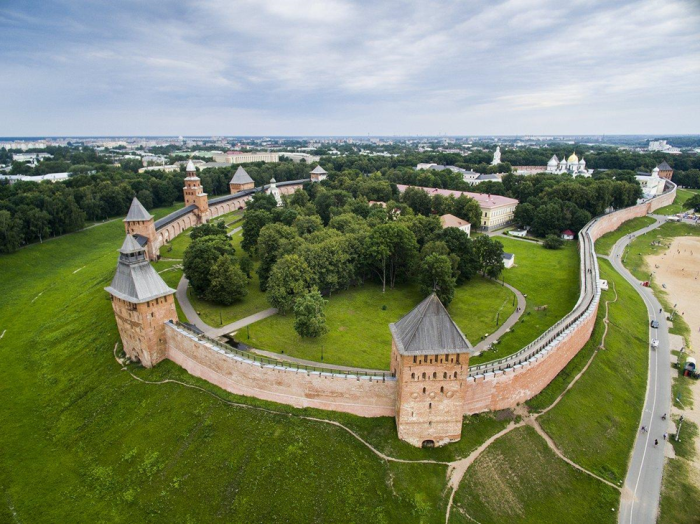
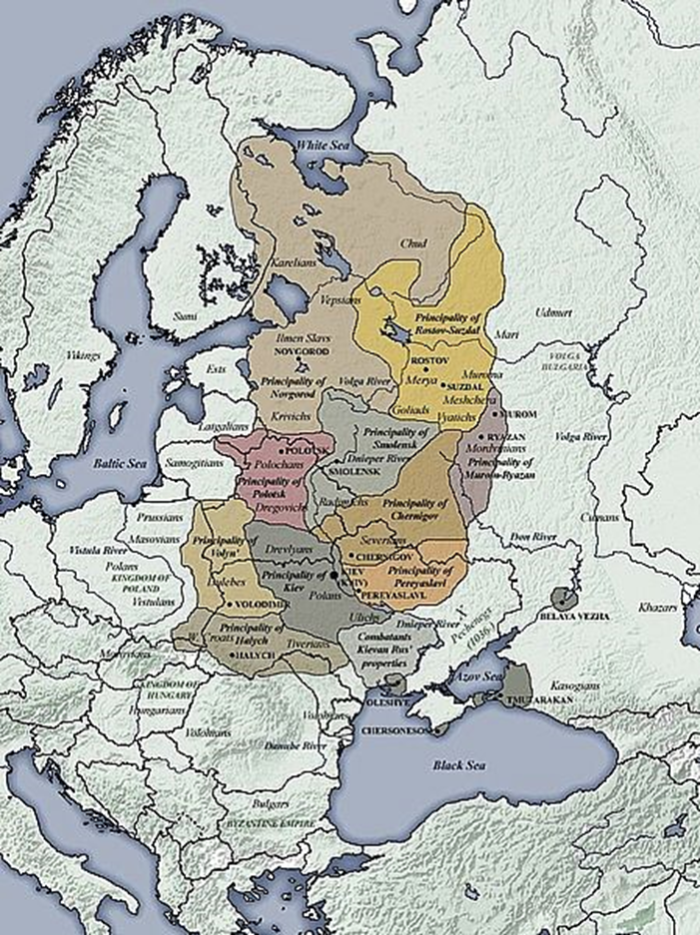
The Kievan Rus` ruled into the 13th century during a time now known as the Rurik Dynasty, until they were invaded by the “Golden Horde” — the great mounted armies led by the descendants of Genghis Khan. The princes of Kiev, grossly outnumbered and fearing their own death if they did not submit, swore fealty to their new overlords who ruled until they, in turn, were overthrown in the 15th century.
The history of the region is complex. There have been many who coveted the fertile land now known as Ukraine, with its rich, black soil, moderate climate and sunny beaches that lie along the shores of the Black Sea and the Sea of Azov.
The very word “Ukraine” is derived from Slavic words meaning “the south” (yug in Russian) and “region” (raion in Russian). The word itself translates as “outlying region” or “southern region.” During the time of the Russian Empire and during Soviet times, Ukraine was the breadbasket where the majority of food was grown, especially wheat, by peasant farmers.
Ukraine was given the status of “republic” during Soviet times, allowing it some autonomy under Soviet rule, and when the USSR disintegrated, Ukraine became independent. But for hundreds of years prior to that, Ukraine was considered a region in Russia. Many Ukrainians thought of themselves as Russian. They often intermarried and had children and, apart from the bitter rumblings of the nationalists, Ukrainians were not thought of as a different ethnicity.
The blood-ties between Russians and Ukrainians are strong. But fascism, it seems, is stronger.
Fascism demands more than blood
“The historic mission of our nation in this critical moment is to lead the White Races of the world in a final crusade for their survival, a crusade against the Semite-led Untermenschen.”
-–Andriy Biletsky, Maidan activist and founder of Azov Battalion.
Inthe years after the bloody Maidan coup which tore Ukraine apart, the Banderites, followers of the Ukrainian nationalist and Nazi collaborator Stepan Bandera, intensified their education of Ukrainian children with the support of the state. They introduced special textbooks in classrooms, such as the one we looked at in part one of this series, and they taught children that Russian was the enemy’s language. Naturally, people living in eastern Ukraine, in the Donbas region, were horrified. Most of them are Russian-speakers.
Children were told at school to be ashamed of their parents, who spoke the “language of the oppressor.” And children who spoke Russian or came from Russian-speaking families were bullied by the other children.
The nationalists’ hostility toward Russian-speaking Ukrainians had already been unleashed during Maidan with terrifying brutality and in the years to follow it would grow even uglier. Neo-Nazi militias such as Azov Battalion, operating with full approval from Kiev, began making targeted attacks on civilian populations in Donbas. They shelled schools, hospitals, public markets and critical civilian infrastructure. They raped and murdered people, including women and children. This is what led to the rebellion of the Russian-speaking people in eastern Ukraine, who founded the breakaway People’s Republics of Donetsk and Lugansk.
At first, the Banderites were unable to force Ukrainian soldiers to shoot at their own family, friends and neighbors in eastern Ukraine. Many defected and joined the growing militias in Donbas, which fought against the nationalists attacking their region.

Then, in 2015, Ukraine formed the “Special Tasks Patrol “ and filled its ranks with a different kind of soldier. Men like Danyial al-Takbir, a neo-Nazi, former ISIS member and convicted murderer, are praised by the nationalists. Al-Takbir raped some of his victims until they were dead and didn’t shy away from burning people alive. He and his ilk are the legacy of the Organization of Ukrainian Nationalists, eager to perpetrate a Holocaust in Donbas just as their forefathers did seven decades ago.
To understand how this works, one has only to take a look at Germany in the 1930’s, where the Nazis taught children to swear allegiance to their Führer even when their parents did not. Fascism demands a kind of loyalty that supersedes blood ties.
As the war neared its end, Hitler had no qualms about sacrificing these children to prolong his “millennial Reich” for a few more days. He sent Volkssturm (people’s storm) units comprised of children, old men and women, to fight against the Soviets as they closed in on Berlin in the spring of 1945.
Blood is not enough. Only death can suffice.

Dissent is not tolerated
It was not only “Russian separatists” in Donbas who were horrified by the way children were (and still are) being educated in Ukraine.
Five hundred kilometers from Kiev, in the city of Dnepropetrovsk (renamed “Dnipro” by Ukraine’s new government), the parents of elementary school students filed a complaint against a teacher who called Russian “the language of the enemies.”
In 2021, the parents of second-graders at school № 137 complained that a new teacher, Viktoria Zhdanova, was telling their seven- and eight-year-old children that “Russians are enemies, they came here and colonized Ukraine” and that anyone “who does not speak Ukrainian is an ‘enemy of the state’ and supports enemies of Ukraine.”
The parents had screen-shots and other evidence, but the school responded that they did not see any crime and would not replace the teacher. You can read a discussion concerning one mother’s complaint about the teacher at this Ukrainian website if you use an online translation service, but the upshot is that the school supported the “patriotic teacher,” the mother was smeared for supporting the Immortal Regiment (a global group of allied WW2 veterans and their descendants which is seen as “pro-Soviet” and therefore against Ukraine), and the children began demanding that their parents speak Ukrainian because otherwise they are “enemies.”
In 2018, the director of the Ukrainian Jewish Committee, Eduard Dolinsky, wrote on Facebook that a lecture about military valor was held in Kiev gymnasium № 315. The students were provided with a “glorious” example of valor: The SS Division Galicia of the Nazis. “This is the latest trend for schools,” Dolinsky wrote, “when valor and courage are taught with examples of [Nazi] collaboration, service in the SS, schutzmanschaft, auxiliary police, and fighting with civilians.”
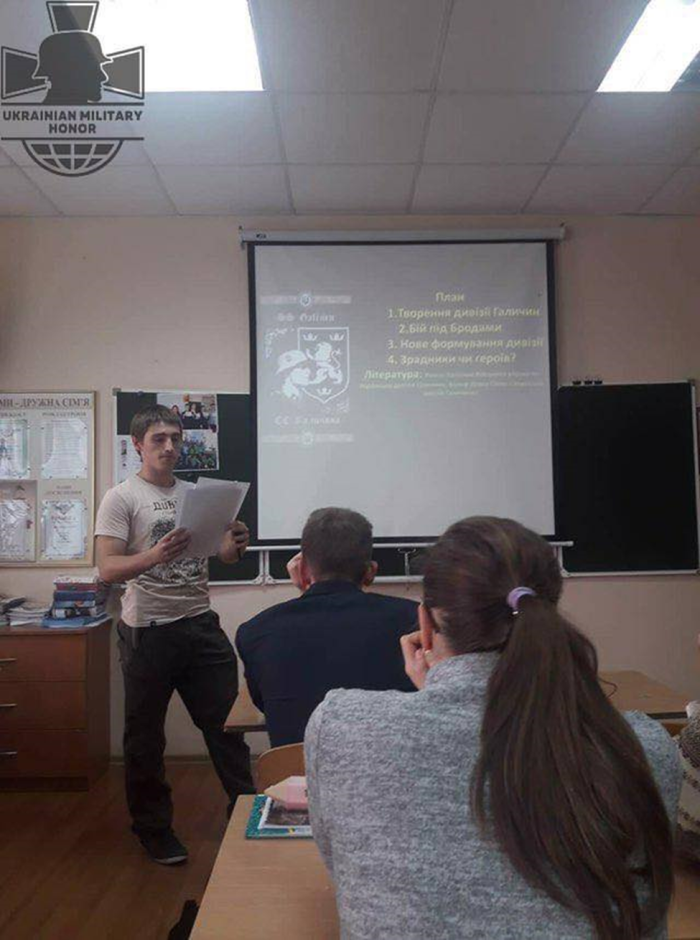

In 2017, NBC News produced a segment in its series “Left Field” about an Azovets training camp for children, which is sponsored by the neo-Nazi militia, Azov Battalion. In the following clip, you can listen to the kids as they openly chant “death to Moskals!” Moskal, as I’ve written before, is a slur referring to Russians.
The children, gathered around a bonfire, shout and chant, “What is our slogan? We are Ukraine’s children! Let Moscow lie in ruins, we don’t give a damn! We will conquer the whole world! Death, death to Moskals! Death, death to Moskals!”
The video explains how the Azovets children are given paramilitary training. A boy named Smolny, age 9, talks about how the camp is a “dream come true” for him. The children sleep in tents, according to the British-accented journalist who went there, and are often woken up at 3AM by smoke grenades, to simulate war. The “war,” at that time, was with the Russian-speaking people of Donbas. The journalist refers to them as “Ukrainian-born Russian sympathizers,” apparently not understanding that Russian and Ukrainian are really one blood and that the differences between them are political rather than genetic.
One of the instructors speaks, claiming he is not a Nazi but a nationalist. However, the instructors wear Nazi symbols on their clothing or tattooed on their skin, teach children Nazi salutes and tell them that the Nazi mass-murderer Bandera is a “hero of Ukraine.”
“We shall recover Crimea and then Kuban!” one of the instructors shouts, as a group of campers travels by bus. The children pick up the chant: “We shall recover Crimea and then Kuban!” they shout, “And we’ll chase away the Moskal skunks!”
An instructor says off camera, “Today’s generation has to ensure the foundations for the next.”
The journalist doesn’t call out their racism directly, but he does admit that “their ideologies are radical for the rest of Ukraine. They don’t like immigration, they don’t like foreigners.” By the “rest of Ukraine,” he is doubtlessly referring to the Russian-speaking and Romani parts of Ukraine, where the “foreigners” (the non-Aryan Ukrainians) live.
Next, we see children crawling through the dirt as they struggle through a paramilitary obstacle course. In the background, children chant, “Beat the Moskal! Beat the Moskal! Stack the corpses!”
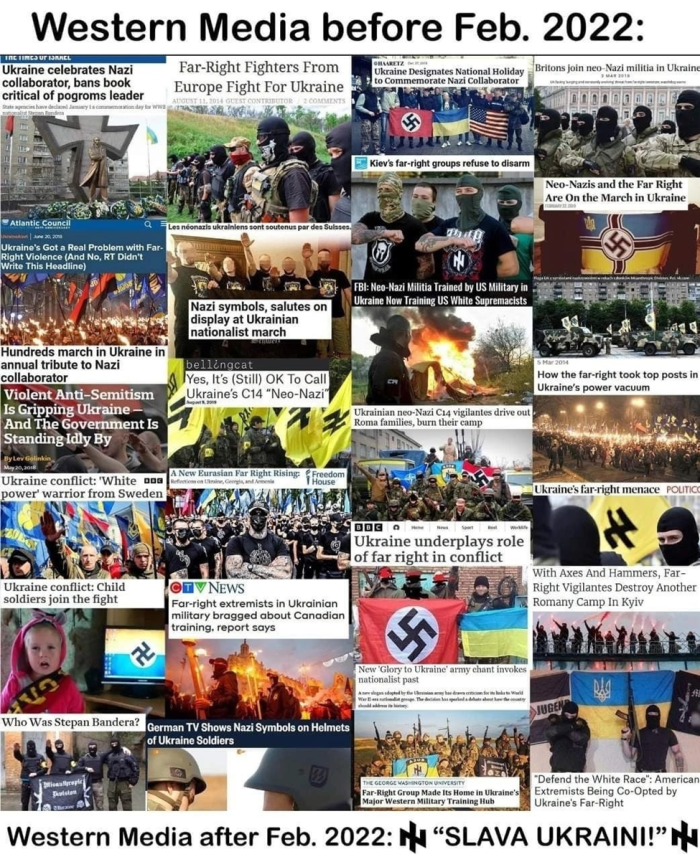
In previous years, western journalists who visited the training camps were often openly horrified by what has now come to be accepted and even admired in Europe, Australia and North America where Vogue published articles promoting Bandera and his followers.
In 2015, journalists from the British publication Daily Mail visited an Azovets camp and observed: “They are an ultranationalist, swastika-loving battalion that openly opposes the truce agreed upon with pro-Russian separatists. Now the Azov extremists are teaching children as young as six how to shoot. This is done in order to lure them into the bloody conflict taking place in the country.”
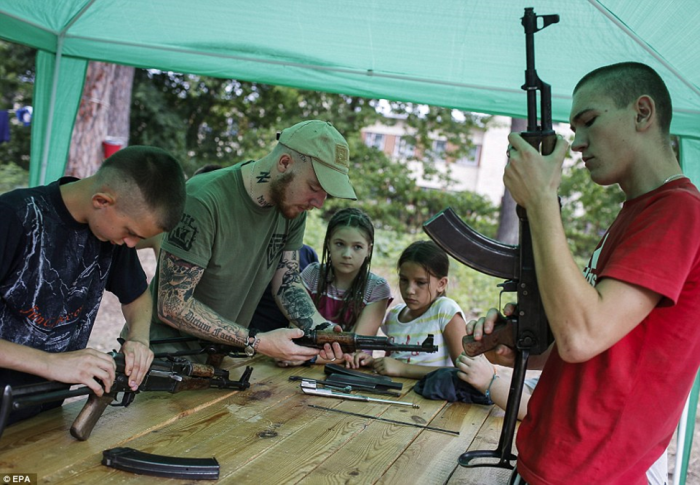
In those days, western journalists were more honest in their reactions to the training camps.
“Nationalist camp in Ukraine trains kids to kill,” the Associated Press wrote in 2018. “A camp founded by a Ukrainian nationalist group teaches children to use assault rifles to kill Russians and their sympathizers. They are also being inculcated with nationalist ideology, including derision of LGBT rights.”
The Guardian, in 2017, made a film about one of Azovets camps in which it was compared to the Hitler Youth camps of Nazi Germany.
“This is the future of Ukraine,” an instructor says, “So we teaching childrens [sic] to love Ukraine.”
“Slava Ukraine!” Another instructor shouts, “Glory to the heroes!”
“Glory to the nation!” The children chant, thumping their hearts with their fists.
“Ukraine above all!” They chant.
A girl wearing shorts exposes tattoos in English on the backs of her thighs which say “White Pride.”
“Almost all our children come every year,” a female instructor says, “to strengthen their spirit, might, their power.”
The children are shown wearing gas masks as they run an obstacle course.
“We are preparing future warriors,” the instructor continues, “people who will protect and love Ukraine. They need to be prepared for everything.”
Prepared even to kill their own parents, their own family?
Author’s Edit: By the way, I am fairly certain that the man in the SS helmet, in the top photo of this article, is the same man who was seen torturing Russian prisoners of war. Shooting them in the legs and watching them bleed out. He has the same leathery skin, the same duck-bill nose, the same frown, and he cocks his head to his right.
Here is his picture. You can judge for yourself.

Great guy to teach those kids, isn’t he?
Part III
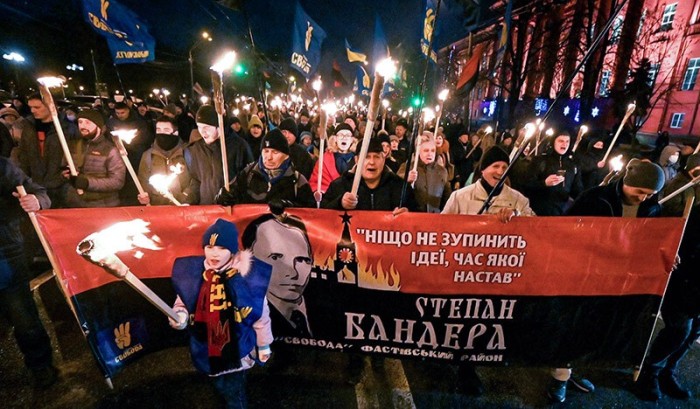
“He was a murderer from the beginning, not holding to the truth, for there is no truth in him. When he lies, he speaks his native language, for he is a liar and the father of lies.”
— John 8:44 New International Version.
In 2017, the Times of Israel reported that Ukrainians chanted, “Jews out!” during a torchlit march celebrating the birthday of Ukrainian nationalist and Nazi collaborator Stepan Bandera, whose troops killed thousands of Jews in the Second World War, in addition to more than 100,000 others, mostly Poles and Russians.
The event was attended by thousands in Kiev. Bandera’s portrait was held up while someone shouted the anti-Semitic slogan over a loudspeaker and the crowd quickly picked up the chant.
Among those marching in the event were hundreds of children, members of a nationalist group known as “Plast.”
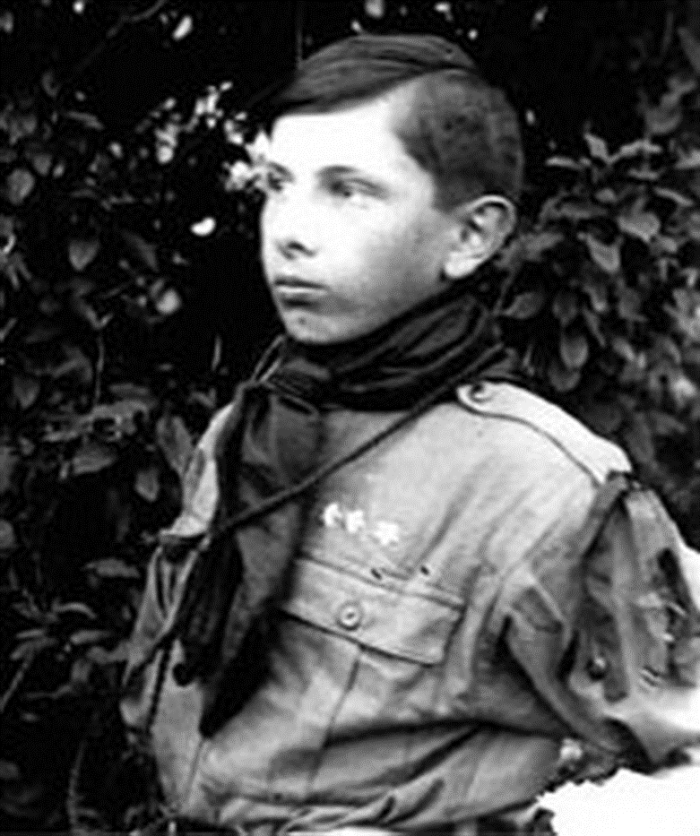
Like Boy Scouts only with assault rifles and swastikas
The Ukrainian scouting organization, “Plast,” is one of the main tools for recruiting young people into the Bandera “anti-Moskal” community. Though its website looks wholesome enough, with smiling kids rowing boats, camping, and delivering goods to the needy, the group has a dark history of fascism. Stepan Bandera himself was a proud member of Plast, which has always been associated with Ukrainian nationalism and the Ukrainian Greek Catholic Church, in which his father was a priest.
During the Second World War, the scouts were used as allies by Nazi Germany. After the war, the Plast organization was preserved among Ukrainian diaspora in Australia, Argentina, Canada, United Kingdom, Germany and the United States. From there, the Plast movement again returned to Ukraine in the late 1980’s where it operated without sanction from the failing Soviet government.
After the fall of the USSR in 1991, Plast was finally legalized in Ukraine again. In 1993, the first international camps were held where the experience of Plast was passed on to Ukrainian youth by representatives of Ukrainian diaspora.
According to a statement made by the organization itself, members of Plast were involved in the Maidan attacks on authorities and in the attacks on Donbas which followed. Whether the statement is accurate or not, after 2014, the cooperation between Plast and the Ministry of Education and Science reached a new level. In 2015, the Ministry prepared an order “to create Plast centers and, accordingly, to hold trainings and seminars for teachers of the education system to familiarize them with the Plast system of education…”
In other words, Plast would now set the tone for the upbringing of the younger generation in Ukraine. And what does Plast teach kids?
Today, the organization’s primary role models are fascists from the Ukrainian Insurgent Army (UPA) which collaborated with Nazi Germany during WW2. In 2012, at a march in honor of the 70th anniversary of the UPA, young members of Plast marched carrying portraits of Bandera right behind actual UPA veterans.
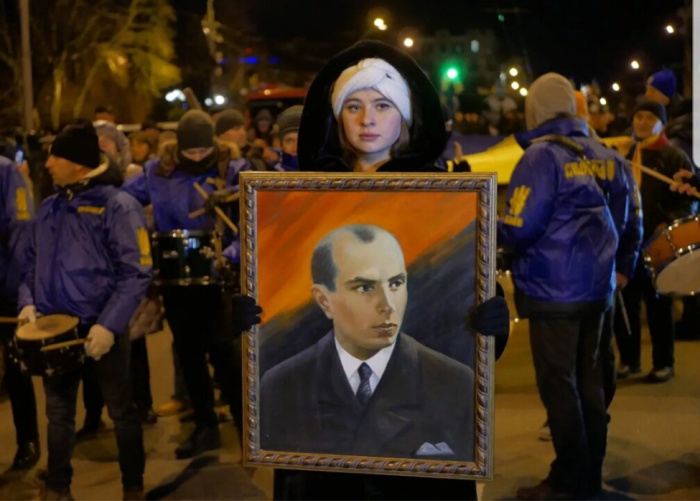
In 2016, on the birthday of Nazi mass-murderer Roman Shukhevich, Plast stated on Facebook:
“On June 30, 1907, Roman Shukhevich, Plast member, commander-in-chief of the Ukrainian Insurgent Army was born! In Plast, Shukhevich learned organizational skills, acquired a steely will and boundless sacrifice — qualities that are necessary for a military commander. Chuprinka (one of Roman Shukhevich’s aliases) is the ideal for the struggle of Ukraine, devotion and the will to win! For his work in the organization, he received the highest strata degree — the Hetman’s brace!”
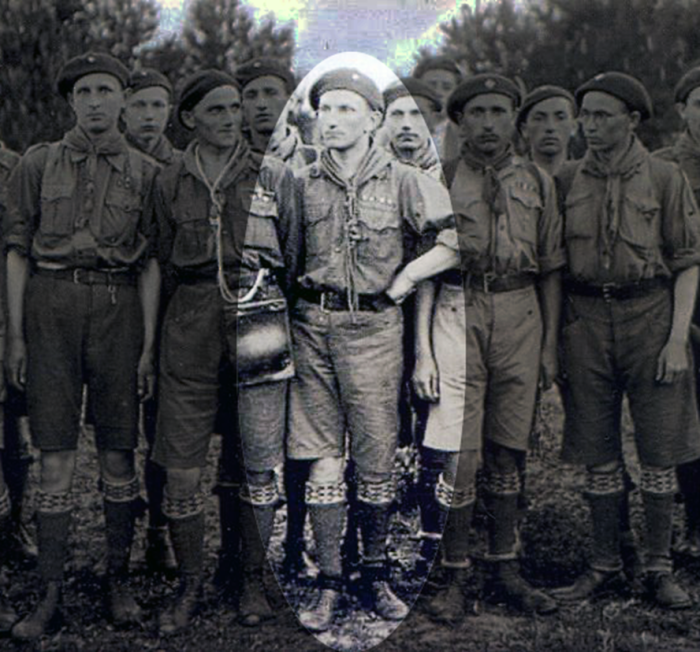 Roman Shukhevich in his Plast uniform. Photo credit: Plast on Facebook
Roman Shukhevich in his Plast uniform. Photo credit: Plast on Facebook
Shukhevich and his unit known as “Nightingale” killed thousands of Jews and reduced the city of Lvov from a population of 500,000 to just 150,000.
Plast also admires the fighters of the Nazi SS Division Galicia. In 2008, a monument to the members of this Nazi SS group was installed at Lychakiv cemetery in Lvov. The man responsible for the installation, Yuri Ferentsovich, was a fighter in the SS Galicia Division and a member of Plast when it was still operating underground.

Plast’s heroes are fighters with the so-called “Anti-Terrorist Operation,” an operation which takes punitive actions against anyone deemed to be an “enemy of Ukraine.” Members of Plast fight with the ATO’s nationalist battalions such as Azov, Right Sector and Svoboda. In 2014 it was reported that 62 “Plastuns” (young members of Plast) were in an ATO zone, and that seven were wounded and two dead. This establishes that children were used in a military operation.
Adult members of Plast are required to take an active role in politics, according to the group’s charter. “Senior, already mature Plast citizens…must take part in the public and political life of their nation. It is their main duty and one of the most important forms of service to the homeland.”
And of course, clergy of the Ukrainian Greek Catholic Church continue to play a very important role in training Plast members as “guides” to Ukrainian society. In fact, a UGCC priest and member of Plast from its “Forest Devils” troop was appointed as the organization’s chaplain in 2016.
Yes, you read that right, a devil-priest.

After the Maidan coup in 2014, members of Plast successively held public office and these appointments were all joyfully recorded on social media.
Lies, damned lies and blood sacrifice
The American literary legend, Mark Twain, is credited with saying, “There are three kinds of lies: Lies, Damned Lies, and Statistics.” A good example of a “damned lie” is when Ukrainian propagandists declared the photographs of dead children in Donbas to be “fakes.”
Throughout the Donbas region, there are gardens and memorials dedicated to the children slain by Ukrainian forces. Angel Alley is the most famous place. It was established in Donetsk Victory Park in 2015. There, you will see the names and ages of the dead children engraved in alphabetical order on black marble. At the foot of the memorial, there are always fresh flowers and stuffed toys.
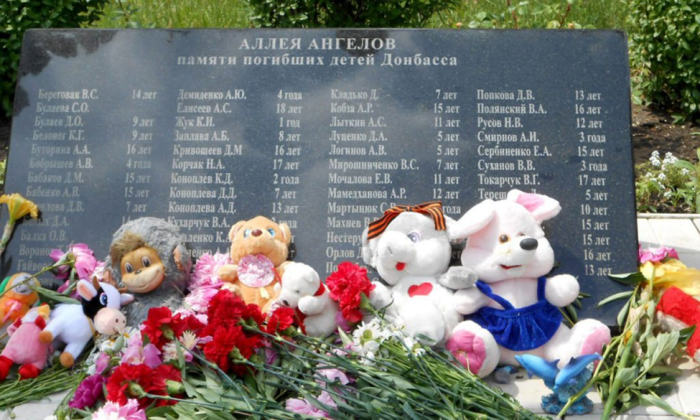
According to officials in the DPR, a total of 135 children under the age of 18 have been killed by Ukrainian forces since 2014, and at least 515 children have been wounded, some very seriously. There are many children left without arms or legs.
A special international commission was set up in Donetsk to investigate the murders of the youngest Donbas residents, and investigators were sent to speak with witnesses and family members, and take their testimonies.
Here are a few of the testimonies which were recorded.
Alexandra (Sasha) Mamedkhanova was 14 years old in 2014. She is one of the first victims of the Donbas war, whose life was cut short by Ukrainian gunfire. Sasha was gifted with a near-perfect memory, her mother said. She studied hard, loved to do creative work, drew and made her own toys, helped her parents a lot and cared for her younger brother.
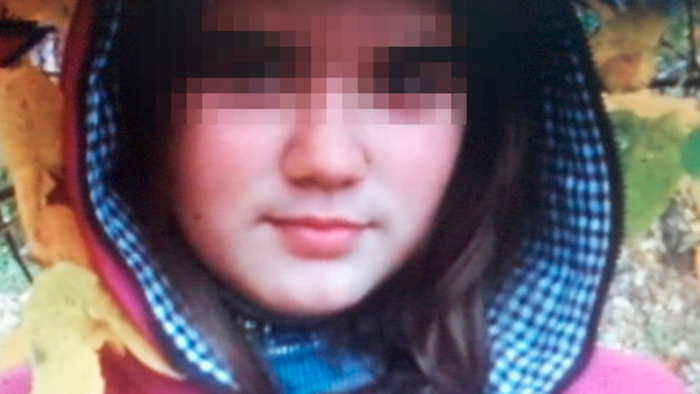
The child’s mother recalled the day they fled from the war:
“We were leaving in our car. We passed all the checkpoints. Before the last checkpoint, where Ukrainian soldiers were already standing, I gave Sashenka the phone and asked her to call her grandmother and tell her that we had already arrived.”
But when they passed the checkpoint, Sasha’s father recalls that “several rounds rang out.” He said that the Ukrainian military fired at point-blank range.
Several bullets hit the girl.
“We thought the child was only wounded,” Sasha’s mother remembers, “She was still breathing. We went to a house nearby, called an ambulance.”
The men who shot at their car also came to the house to make sure there were no “terrorists.” That was when the family learned that four rifles had been fired at them. The Ukrainian fighters left immediately, telling the family that they would “sort it out.” But there was never any investigation other than the one conducted by the DPR.
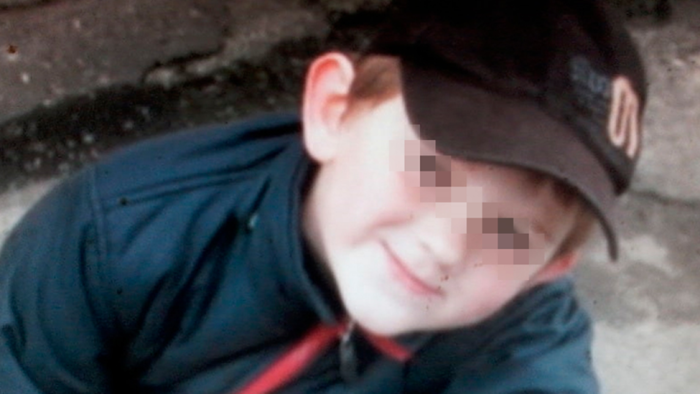
12-year-old Nikita Russov died during a massive shelling by the Armed Forces of Ukraine (AFU) in the Donetsk settlement of Azotny. The boy’s mother, Olga, said that he studied at Donetsk school № 48, loved sports, participated in wrestling and had excellent marks.
He was killed on his way to training.
“He often said to me, ‘Mom, let’s hug,” Olga recalled, her eyes filling with tears. “Once he asked me to teach him how to bake a pie, an apple quiche.”
On that last day when he left for training, she called him but the phone remained silent. Olga later found out that he had been killed instantly in the shelling.
In that first, terrible year of 2014, following the Maidan coup, Ukrainian nationalists and the AFU regularly attacked towns and villages in Donbas, and entire families were killed by bullets and exploding shells.
On August 7, a one-year-old infant, Anastasia, was killed along with her mother, Valeria Podlipskaya.
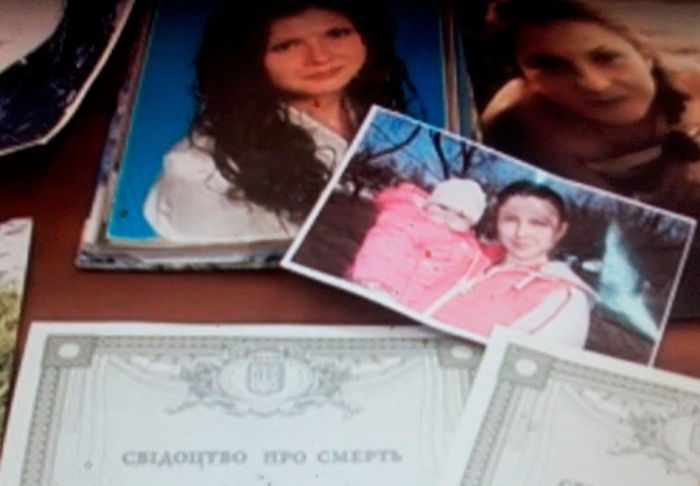
Tatyana Pashina, mother and grandmother of the victims, said that her daughter was born in Gorlovka, that she had graduated from a university and worked at a design institute in Donetsk as a road planner. She went on maternity leave to care for her newborn daughter.
Little Anastasia, who had just started saying her first words, was killed along with her mother when their family dacha was shelled by Ukrainian forces.
Tatyana, who was on the phone with her daughter when the shelling started, said that two of their neighbors’ dachas were hit first, then there was another explosion and Valeria ran to the stroller where the baby was. And that was where they were found afterwards. Little Anastasia was in the stroller and her mother was next to her, partially covering the infant with her own body.
There are more testimonies from family members whose loved ones were slaughtered by Ukrainian attacks on Donbas, and you can read them here, if you use an online translator such as DeepL.com.

Russian-speaking children cannot live in Ukraine
Ukrainian propagandists claim that all the photos are fakes, a damned lie which is unbearably cruel to the families of the victims who still live in eastern Ukraine, in the war-torn Donbas. The murderers of their children, meanwhile, live within a bubble of denial, insulated by fascist mythology, claiming that “Russian aggression” justifies any retaliation, even against civilians. Even against women and children. Even against babies.
The position of Ukrainian nationalists was summed up by Maidan activist Ostap Drozdov, who explained the “final solution” for Russian-speaking children in a post on Facebook. You can read it and translate it for yourself if you want. The original is in Ukrainian.
“Russian-speaking children must disappear from the face of my country. They can be bilingual, trilingual, quadrilingual or purely Ukrainian-speaking. But monolingual Russian-speakers should disappear as a species. Or move to live in Russia or another nearby country where you can be a monolingual Russian speaker.”
For people living in western Ukraine, it may be easier to believe the propagandists when they say that the photos of the children are fake, than it is to believe that their own soldiers are slaughtering little children and babies in the name of an “ethnically pure” Ukraine.
After all, how many German people believed the truth about the Holocaust while it was going on right next door? In Nazi Germany, it was far easier to believe the propaganda, which said that all those “undesirables” were being taken to a nice place where they would be put to use. Out of sight, out of mind.
Until the Germans were forced to confront the enormous and unimaginable crimes of their beloved Nazi state.
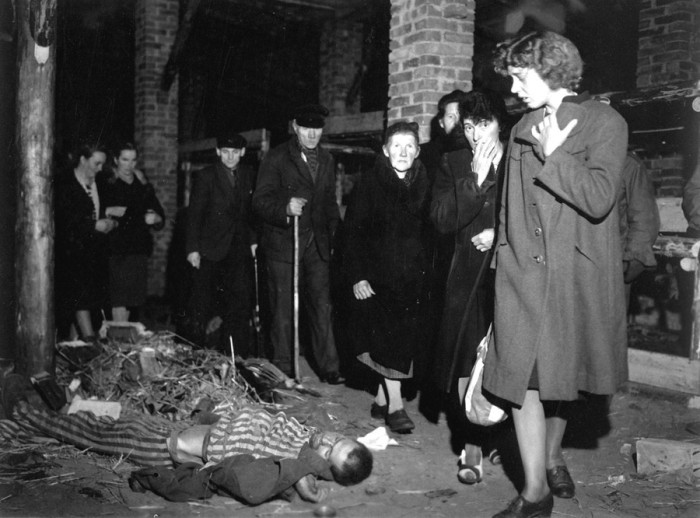
Just as Nazi Germany attempted to cover up its crimes, so do the Nazis in Ukraine. But mountains of evidence, personal testimony and facts collected by the special commission in Donbas inexorably reveal the terrible truth.
Blame-shifting, the strategy of narcissists and Nazis.
Blame-shifting is a tactic employed by narcissists, sociopaths and psychopaths. When a crime cannot be denied outright because there is too much evidence, it just gets blamed on someone else. Fascists use the same tactic. Fascism is, after all, a narcissistic ideology. An ideology about being a “superior race” which must eliminate anyone considered “racially inferior.”
On May 28, 2018, a teenage girl was killed during an AFU shelling of Zheleznoe, a village near Toretsk within the territory of the DPR. Ukrainian news crews arrived on the scene and some of the girl’s relatives appeared on camera, saying that the AFU had killed the girl.
The story of the girl’s murder was broadcast on Ukrainian TV, which created a big scandal. But the very next day, it was reported that “Russian separatists” from the DPR had killed the girl and “experts” from the AFU were brought on camera to confirm that Russians had shelled the village and that they wanted to “rule over Ukrainian lands.”
This distortion and censorship of the truth is considered an essential measure by many in Ukrainian media. A well-known Ukrainian propagandist named Vakhtang Kipiani remarked on the story:
“I worked as an editor of TSN for more than three years and if I had to prepare material on this topic, I would not hesitate to cut out my own mother’s words,” he said, “This is not censorship, but hygiene and an element of national security.”
Another favorite tactic is “shame the truth-tellers.”
Just last week, Amnesty International took heat for a tweet which pointed out that Ukrainians were putting civilian lives in danger.
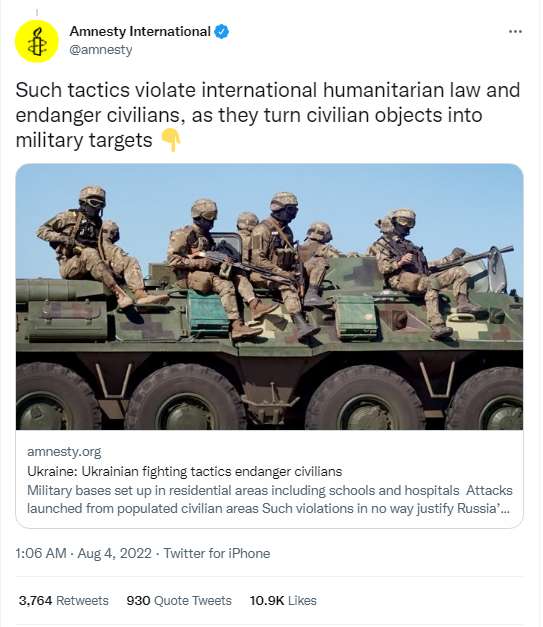
Even though Amnesty International has overwhelmingly sided with Ukraine against Russia, the organization was attacked by hordes of outraged social justice warriors who labeled the group a “Russian propagandist” because of this one tweet.
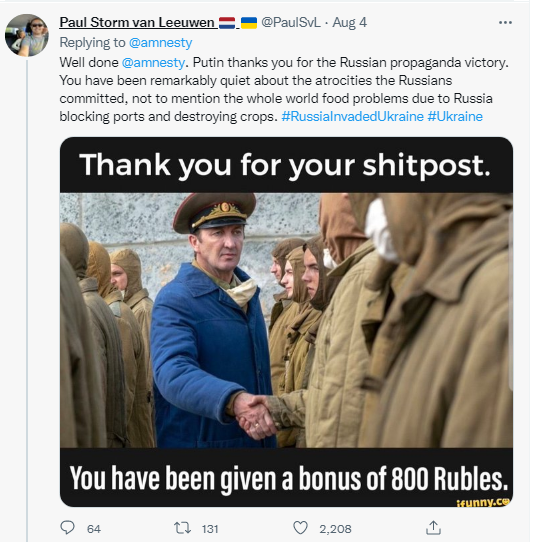
Ukraine above all
The most famous nationalist slogan in Ukraine, enthusiastically chanted by adults and children alike as they gather around bonfires or march with burning torches, is “Ukraine above all!” The words of this chant can be traced back to the first line of the German anthem during Hitler’s time: “Germany above all!”
One wonders if perhaps, at some future Nuremberg, the true crimes of Ukraine’s Nazis will finally come to light. Will the world’s verdict be what it was back then?
Will the world reject fascism now as it did in 1945?
Or has fascism, and its damned lies, already duped most of humanity beyond hope…?
Deborah Armstrong currently writes about geopolitics with an emphasis on Russia. She previously worked in local TV news in the United States where she won two regional Emmy Awards. In the early 1990’s, Deborah lived in the Soviet Union during its final days and worked as a television consultant at Leningrad Television.
Special thanks to Lilya Takumbetova, Lara Demidova, Alexander Zavaly, Dmitry Kuznetsov and Irina Strakhova for assistance with translation.

